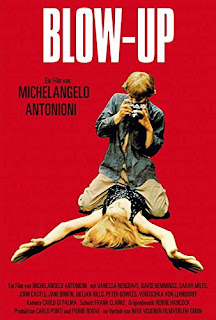Friday, September 14, 2018
Short Take: Blow-Up
Michelangelo Antonioni is among the most glamour-minded of filmmakers. It’s only fitting that Blow-Up, one of his best efforts, is about a fashion photographer. The fellow (played by David Hemmings) is young, wealthy, handsome, and a minor celebrity. The film is more or less a day-in-the-life portrait. There’s him at work, such as the session with a high-end model that’s hilariously staged as a mock sexual tryst. And there’s him at play: tooling around London in his Rolls Royce convertible; shopping for antiques; having a spur-of-the-moment threesome with a pair of groupies. His life is breezy and hedonistic, and quite enjoyable to watch. A great deal of the pleasure comes from the film’s gorgeous visuals. Antonioni’s distinctive style of shot composition and choreographic staging is on terrific display. Working with cinematographer Carlo di Palma, art director Assheton Gordon, and costumer Jocelyn Rickards, he also gives the picture a bold, colorful Pop look. The story gets some melodramatic spice when the photographer, while developing some random photos, believes he may have inadvertently photographed a murder. There are signs of a conspiracy, and the photographer becomes fixated on finding a woman (Vanessa Redgrave) who may be a key to the mystery. These scenes highlight an undercurrent of priggish hand-wringing about the photographer's carefree attitude and the licentious social atmosphere, but Antonioni doesn’t push it too hard. This section of the film has too much to enjoy on its surface. The sequence in which the photos of the murder are developed is dazzlingly edited and sleekly suspenseful. Hitchcock never did it better. Afterward, the viewer is treated to a club performance by the Yardbirds, and a low-key slapstick encounter with a mime troupe. It’s so entertaining one may not even notice the moralizing. The film is a wonderful showcase for the elegance of Mod style, and it captures the naughty chic of 1960s “Swinging London.” The script, credited to Antonioni, Tonino Guerra, and Edward Bond, was inspired by the Julio Cortázar short story “Las babas del diablo.” Herbie Hancock provided the non-diegetic music.
Subscribe to:
Post Comments (Atom)

No comments:
Post a Comment